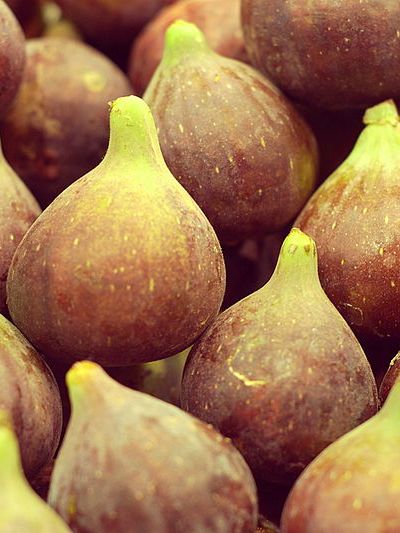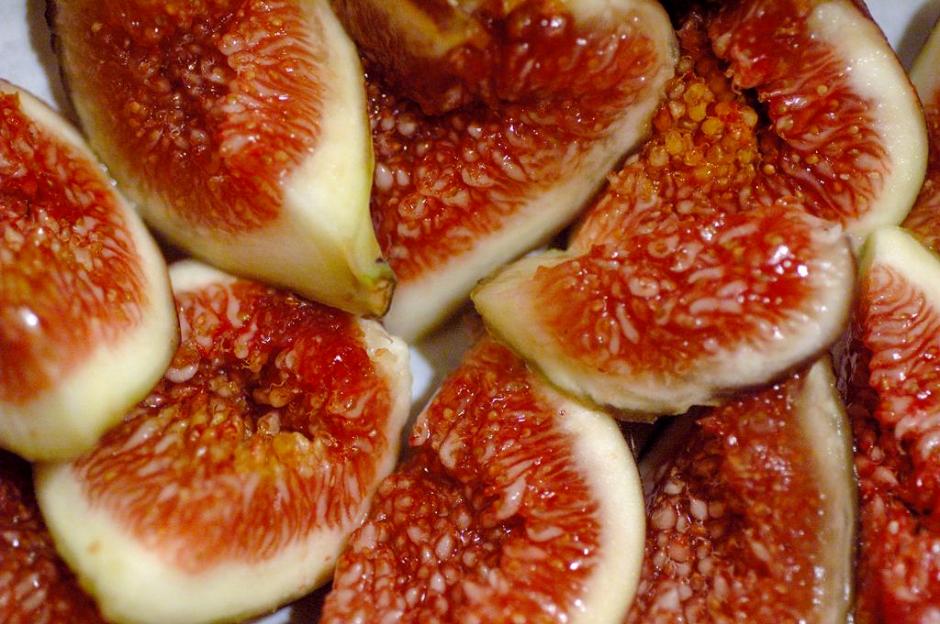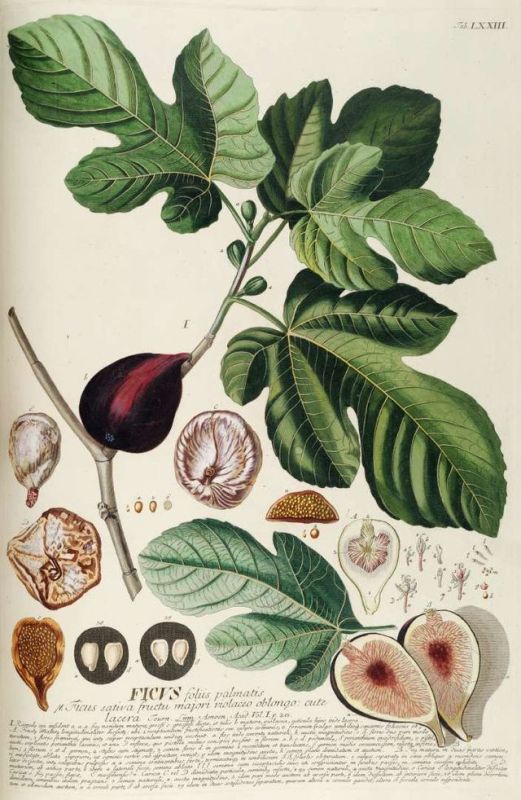March 1 - 7, 2015: Issue 204
Figs have two seasons. A quick, shorter season in early Summer and a second, main crop that starts in late Summer and runs through Autumn. Some sources we researched show these fruits have been around for ten thousand years! And of course, they were the fig leaves donned by Adam and Eve when humankind fell from grace.
Best eaten just as is, there are also a few recipes we offer to enjoy this wonderful end of Summer fruit if you do get some that area bit dry, not so sweet, or simply wish to celebrate this glorious age old fruit in ways that will set off its delicate flavours and enyance the eating of figs, glorious figs.
You can use these wonderful fruits in savoury dishes as they do well as an accompaniment for poultry and pork. Our focus is on appetizers and desserts that star the fruit as the central theme of these dishes:
 Fig Bruschetta Recipe
Fig Bruschetta RecipeServes 3-4
The addition of the fig compote on the bruschetta adds another layer of wonderful fig flavor and texture. But if you don't have time to make the fig compote, plenty of fresh, sweet figs on top will be equally delicious.
Ingredients:
For the Roasted Fig Puree Recipe:
• 225g ripe figs
• 2 Tablespoons (30ml) balsamic vinegar, divided
• 1 Tablespoon (15g) brown sugar
For the Fig Bruschetta assembly:
• Crusty bread loaf or baguette, sliced thin or grilled (optional)
• Olive Oil for brushing the bread, if you are serving it grilled
• 5-6 ripe figs, quartered
• 1 cup Ricotta Cheese
• 1/4 cup chopped pecans
• Fresh thyme leaves
Roasted Fig Puree Directions
Preheat the oven to 180°c. Slice the tough stems off of the figs then slice the figs into quarters. Place the figs in a baking dish and toss with one Tablespoon of balsamic vinegar and brown sugar. Cover the baking dish with foil and roast for 15-20 minutes or until the figs are soft. When cool enough to handle, puree the figs in a food processor or blender with the remaining tablespoon of balsamic vinegar (feel free to add more balsamic to taste). Put puree in a bowl and place in fridge to cool until ready to use
Bruschetta Directions
If you are grilling the bread: heat the grill and lightly brush each sides of sliced bread with olive oil. Grill each side of the bread till crisp. Spread ricotta cheese over each slice of bread. Top each bread slice with fig puree, pecans, fresh figs and fresh thyme leaves. Serve on a platter or wood cutting board as the perfect appetizer.
From a great idea by Todd Porter and Diane Cu
Roasted Kale or Spinach, Avocado and Fig Salad
Ingredients serves 2 or 4 as a side dish
• 1 head of kale (I used curly leaf kale)
• 1 large avocado, cored, peeled, and sliced
• 2-4 figs depending on the size, sliced
• 1/2 red onion, sliced
• 1 1/2 tablespoons olive oil
• juice from half a lime
• salt & pepper to taste
Preheat oven to 180 degrees Celsius. Remove the stems of the kale and cut into bite sized pieces. In a large bowl, rub the olive oil into the kale and season with salt and pepper. Place kale on baking sheets and roast for approximately 15-20 minutes or until kale starts to crisp up. To assemble, make a bed of the roasted kale on a plate. Sprinkle the red onions, figs, and avocado slices on top. Season more if desired with salt, pepper. Drizzle with a dash more of olive oil and squeeze the lime juice over.
Turkish yogurt cake with figs
Ingredients (for a 22cm/9-inch spring pan):
4 large eggs, separated
1/2 cup cane sugar
3 tablespoons Plain flour, sifted
1 1/2 cups Greek yogurt
grated zest + juice of 1/2 lemon
1 1/2 teaspoons orange blossom water
4 fresh figs, halved
Preheat the oven to 180 degrees C. In a large bowl, beat the egg yolks with the sugar until creamy and light. Add the flour and mix until combined. Add the yogurt, lemon zest and juice and mix until combined. Add orange blossom water. Whisk egg whites using electric beaters until firm and fluffy. Gently fold into yogurt mixture until combined, from the bottom to the top, using a spatula.
Grease a spring-form cake pan with butter. Pour mixture into the pan and arrange the fig slices on top. face up. Bake it in the oven for 50 minutes or until the top is browned. The cake will rise a lot but will decrease when removed from the oven. Let cool before serving.
There area few versions of this cake but we love the one by Valeria at Life, Love Food blog

Fig sections - photo courtesy Eric Hunt.
The common fig
 The common fig (Ficus carica) is a species of flowering plant in the genus Ficus, from the family Moraceae, known as thecommon fig (or just the fig). It is the source of the fruit also called the fig, and as such is an important crop in those areas where it is grown commercially. Native to the Middle East and western Asia, it has been sought out and cultivated since ancient times, and is now widely grown throughout the temperate world, both for its fruit and as an ornamental plant.
The common fig (Ficus carica) is a species of flowering plant in the genus Ficus, from the family Moraceae, known as thecommon fig (or just the fig). It is the source of the fruit also called the fig, and as such is an important crop in those areas where it is grown commercially. Native to the Middle East and western Asia, it has been sought out and cultivated since ancient times, and is now widely grown throughout the temperate world, both for its fruit and as an ornamental plant.
The common fig tree has been cultivated since ancient times and grows wild in dry and sunny areas, with deep and fresh soil; also in rocky areas, from sea level to 1,700 meters. It prefers light and medium soils, requires well-drained soil, and can grow in nutritionally poor soil. Like all fig trees, Ficus carica requires wasp pollination of a particular species of wasp (Blastophaga psenes) to produce seeds. The plant can tolerate seasonal drought, and the Middle Eastern and Mediterranean climate is especially suitable for the plant. Situated in a favorable habitat, old specimens when mature can reach a considerable size and form a large dense shade tree. Its aggressive root system precludes its use in many urban areas of cities, but in nature helps the plant to take root in the most inhospitable areas.
Ecology
Ficus carica is dispersed by birds and mammals that scatter their seeds in droppings. Fig fruit is an important food source for much of the fauna in some areas, and the tree owes its expansion to those that feed on its fruit. The common fig tree also sprouts from the root and stolon issues.
The infructescence is pollinated by a symbiosis with a kind of fig wasp (Blastophaga psenes). The fertilized female wasp enters the fig through the scion, which is a tiny hole in the crown (the ostiole). She crawls on the inflorescence inside the fig and pollinates some of the female flowers. She lays her eggs inside some of the flowers and dies. After weeks of development in their galls, the male wasps emerge before females through holes they produce by chewing the galls. The male wasps then fertilize the females by depositing semen in the hole in the gall. The males later return to the females and enlarge the holes to enable the females to emerge. Then some males enlarge holes in the scion, which enables females to disperse after collecting pollen from the developed male flowers. Females have a short time (<48 hours) to find another fig tree with receptive scions to spread the pollen, assist the tree in reproduction, and lay their own eggs to start a new cycle.
History
The edible fig is one of the first plants that was cultivated by humans. Nine subfossil figs of a parthenocarpic (and therefore sterile) typedating to about 9400–9200 BC were found in the early Neolithic village Gilgal I (in the Jordan Valley, 13 km north of Jericho). The find predates the domestication of wheat, barley, and legumes, and may thus be the first known instance of agriculture. It is proposed that this sterile but gustatively desirable type was planted and cultivated intentionally, one thousand years before the next crops were domesticated (wheat and rye).
Figs were also a common food source for the Romans. Cato the Elder, in his De Agri Cultura, lists several strains of figs grown at the time he wrote his handbook: the Mariscan, African, Herculanean, Saguntine, and the black Tellanian (De agri cultura, ch. 8). The fruits were used, among other things, to fatten geese for the production of a precursor of foie gras.
It was cultivated from Afghanistan to Portugal, also grown in Pithoragarh in the Kumaon hills of India. From the 15th century onwards, it was grown in areas including Northern Europe and the New World. In the 16th century, Cardinal Reginald Poleintroduced fig trees to Lambeth Palace in London.
The common fig tree has been cultivated since ancient times and grows wild in dry and sunny areas, with deep and fresh soil; also in rocky areas, from sea level to 1,700 meters. It prefers light and medium soils, requires well-drained soil, and can grow in nutritionally poor soil. Like all fig trees, Ficus carica requires wasp pollination of a particular species of wasp (Blastophaga psenes) to produce seeds. The plant can tolerate seasonal drought, and the Middle Eastern and Mediterranean climate is especially suitable for the plant. Situated in a favorable habitat, old specimens when mature can reach a considerable size and form a large dense shade tree. Its aggressive root system precludes its use in many urban areas of cities, but in nature helps the plant to take root in the most inhospitable areas. Common fig tree is mostly a phreatophyte that lives in areas with standing or running water, grows well in the valleys of the rivers and ravines saving no water, having strong need of water that is extracted from the ground. The deep-rooted plant searches groundwater, in aquifers, ravines, or cracks in the rocks. The fig tree, with the water, cools the environment in hot places, creating a fresh and pleasant habitat for many animals that take shelter in its shade in the times of intense heat.
Common fig. (2015, February 6). In Wikipedia, The Free Encyclopedia. Retrieved from http://en.wikipedia.org/w/index.php?title=Common_fig&oldid=645937344
Illustration: Trew, C.J., Plantae selectae quarum imagines ad exemplaria naturalia Londini, in hortis curiosorum nutrit, vol. 8: t. 73 (1771) [G.D. Ehret]
Copyright Pittwater Online News, 2015. All Rights Reserved.